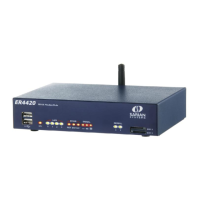SNMP parameters
Digi TransPort User Guide 642
SNMP Trap Server parameters
Digi TransPort routers support two SNMP trap servers. The following options and description
explain how to configure a trap server.
Trap Server IP Address a.b.c.d
The IP address of the server running the SNMP software and determines the destination for
the trap notifications.
Port n
The UDP port number that the SNMP server is listening on, the default is 162, which is the
standard port number for this service.
Use SNMP Version
Select the required SNMP version number from this drop-down selection box.
Send “Inform Request” message
If SNMP version 2c or 3 is selected, the router can send a SNMP Inform Request message
instead of a Trap message. Inform Request messages are acknowledged by the SNMP Trap
server whereas Trap messages are not.
If no response, retransmit the Inform Request message after n seconds
The period after which the Inform Request message is retransmitted if no response has been
received.
Retransmit a maximum n times
The maximum number of times an Inform Request message is retransmitted. If no
acknowledgment is received after the maximum number of retransmissions, an event is
logged.
Community
Enter the desired community string into this text entry box.
Confirm Community
Entering the community string again here enables verification of the string since the string is
not displayed.
Trap Server Engine ID
This item will be configured within the application and is the SNMP server software engine ID
which is used for authentication and encryption.
SNMP User
The username that should be associated with the trap server. This should match a user from
one of the previously configured SNMP users (Configuration > Remote Management >
SNMP > Users).
User Security Level
Select the desired security level from this drop-down selection box. The choices are these:
• No Authentication, No Privacy
• Authentication, No Privacy
• Authentication, Privacy

